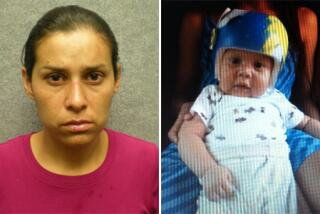Boy, 16, Convicted for Dropping Rock Onto Car on Freeway
- Share via
A Juvenile Court judge found a 16-year-old Golden Hill boy guilty Thursday of three counts of assault with a deadly weapon for throwing a rock from an Interstate 5 bridge, critically injuring a San Carlos man.
But Judge Lawrence Kapiloff urged “not punishment but understanding” for the troubled teen-ager and ordered immediate psychiatric counseling, to begin before the scheduled May 20 sentencing.
“You don’t take a young man like this and put him away forever,” Kapiloff said, ending the trial after two days of deliberations. “The impetus has got to be rehabilitation.”
‘Sense of Compassion’
Directing his remarks toward a half-dozen reporters in the courtroom, Kapiloff said: “I think you’ve heard enough about (the boy) and his life. Have a sense of compassion for this troubled youth.”
The three counts stem from a Feb. 29 incident in which 24-year-old Kurt Meyering was struck in the head with a 6-pound chunk of concrete hurled from the Broadway overpass above I-5 downtown. Meyering was driving a 1984 red Corvette and his girlfriend, Jane Casey, 22, was a passenger. Moments before Meyering was hit and the car crashed, a Datsun driven by San Diego teacher Billie Wilson was also struck with a rock.
Meyering is in fair condition at Mercy Hospital and is “out of a life-threatening situation,” spokeswoman Laura Avallone said.
A 13-year-old Point Loma boy charged in the same incident pleaded no contest to three counts of assault with a deadly weapon April 14 and is scheduled to be sentenced next month.
In finding the second defendant “jointly culpable,” Kapiloff said, “We only know that it was done deliberately and that it will have a profound effect on the lives of two people.”
The boy’s mother angrily charged out of the courtroom after the verdict.
Verdict Called ‘Fair’
Casey, who testified Wednesday how the she tried to gain control of the car after Meyering was hit, said outside the courtroom that the verdict was “very fair.”
But, she added, “I just hope that Kurt is out walking the streets before the two boys that did this.”
“I have my emotions on hold,” Casey said. “It’ll probably hit me tonight.”
In his closing remarks, prosecutor Robert Amador maintained that the 16-year-old lied in a taped interview with San Diego police detectives March 8. In the interview, which was played in court Wednesday, the older boy said the 13-year-old hurled the concrete chunk onto the freeway because he was bored and later laughed as he peered down from the bridge to see the car careening out of control.
“He told police who it was that threw the rock,” Amador said, “and, boy, he was sure that person was going to be stuck for throwing that rock.”
Amador argued that the younger boy is only 5 feet, 5 inches tall, making it improbable for him to have reached over the bridge’s 6 1/2-foot-high railing and have thrown the rock the way the 16-year-old described. The defendant is about 5 feet, 10 inches tall.
“It’s improbable, if not impossible, that (the 13-year-old) made the motions described by (the older boy),” Amador said. “He told what he had done, but he blames that action on (the 13-year-old.)”
Testimony About Bet
Amador also pointed to Tuesday’s testimony by another 16-year-old, who had been in Juvenile Hall with the boys charged in the rock throwings. The teen-ager testified that he had been told that the 16-year-old bet the younger boy $1 he wouldn’t throw the rock onto the freeway.
Further, the prosecutor said that the rock found in the Corvette had no traces of paint from the blue Datsun, which had been hit moments earlier, and that the proximity in time of the two incidents reinforced his theory that more than one rock was thrown.
In closing arguments, defense attorney Jerry Leahy concentrated on the boy’s troubled past, saying the youth had been kicked out of his house the day detectives picked him up for questioning, had broken curfews many times and was “totally unsupervised and uncontrolled.”
The attorney said the boy might have invented the statements he made to police to get attention.
“Maybe this young man was crying out for help,” he said. “He wanted to be important . . . to be the center of attention, for someone to care about him. And he had a chance.”
More to Read
Sign up for Essential California
The most important California stories and recommendations in your inbox every morning.
You may occasionally receive promotional content from the Los Angeles Times.













